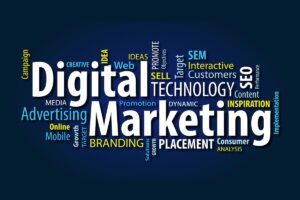In the ever-evolving landscape of online marketing, it’s crucial to distinguish between two essential strategies: Digital Marketing and SEO (Search Engine Optimization). These terms are often used interchangeably, but they represent distinct approaches to enhancing your online presence and achieving business objectives. In this comprehensive guide, we will explore the key differences between Digital Marketing and SEO, helping you gain a clearer understanding of how each can benefit your online endeavors.
Defining Digital Marketing and SEO
To start, let’s define Digital Marketing and SEO separately before diving into their differences.

Digital Marketing
Digital Marketing encompasses a broad spectrum of online activities aimed at promoting a brand, product, or service. It leverages various digital channels and platforms, including websites, social media, email marketing, content marketing, pay-per-click (PPC) advertising, and more. The primary goal of digital marketing is to reach and engage a target audience, ultimately driving conversions, sales, or other desired actions.
SEO (Search Engine Optimization)
SEO, on the other hand, is a specific subset of digital marketing focused on optimizing a website’s visibility in search engine results pages (SERPs). The objective of SEO is to enhance a website’s organic (non-paid) search engine rankings, thereby increasing the likelihood of attracting organic traffic. SEO involves both on-page and off-page strategies, such as keyword research, content optimization, link building, and technical improvements.
Objectives and Goals
Now that we have established the definitions of Digital Marketing and SEO, let’s explore their divergent objectives and goals.
Digital Marketing Goals
Digital Marketing aims to achieve a wide range of objectives, including:
Building brand awareness and recognition. Expanding the online presence across multiple digital platforms. Engaging with the target audience through various content types. Generating leads and conversions through paid advertising. Enhancing customer loyalty and retention through email marketing. Tracking and analyzing user behavior for data-driven decision-making.You can also read Invoice Scanning Software for Your Business
SEO Goals
SEO, on the other hand, has a more specific set of goals, such as:
Improving organic search engine rankings for relevant keywords. Increasing the visibility of a website in SERPs. c. Attracting high-quality organic traffic. Enhancing the user experience and website performance. Establishing authority and credibility in a particular industry or niche. Maximizing click-through rates (CTR) from search results.
Key Differences in Approach
While both Digital Marketing and SEO share the overarching goal of enhancing online visibility and attracting visitors, their approaches are fundamentally distinct.

Paid vs. Organic
One of the primary distinctions is the source of traffic:
Digital Marketing relies on paid advertising campaigns, where businesses allocate budgets for ads on platforms like Google Ads, social media ads, and sponsored content placements. This approach yields immediate visibility but requires ongoing investment.
SEO focuses on organic traffic, achieved through unpaid methods. SEO specialists work on optimizing website elements, creating valuable content, and building high-quality backlinks to improve rankings. While it may take time to see significant results, organic traffic can be a sustainable, cost-effective source of visitors.
Timeframe
The timeframe for achieving results differs significantly between Digital Marketing and SEO:
Digital Marketing campaigns can yield quick results, as ads can be launched and seen by the target audience almost instantly. However, the effectiveness of these campaigns may diminish once the budget is exhausted.
SEO is a long-term strategy that requires patience. It can take several months to see substantial improvements in organic rankings. Yet, once a website establishes a strong presence, the benefits can be enduring, providing a consistent stream of organic traffic.
Cost Structure
The cost structure of Digital Marketing and SEO varies
Digital Marketing involves ongoing expenses related to advertising budgets. Businesses must allocate funds for ad placements, clicks, impressions, and other metrics, which can add up quickly.
SEO investments primarily include upfront costs for website optimization, content creation, and link building. While there are ongoing maintenance expenses, they tend to be lower than the continuous spending associated with digital advertising.
Overlapping Strategies
It’s important to note that Digital Marketing and SEO are not mutually exclusive. In fact, they often complement each other in a comprehensive online marketing strategy.

Content Marketing
Both Digital Marketing and SEO heavily rely on content marketing. Content serves as the backbone of SEO efforts, where high-quality, optimized content helps improve search rankings and engage users. In Digital Marketing, content is used to drive engagement, conversions, and brand awareness across various platforms.
Social Media
Social media plays a crucial role in Digital Marketing, as businesses utilize platforms like Facebook, Instagram, Twitter, and LinkedIn to connect with their audience. SEO indirectly benefits from social media, as social signals (shares, likes, comments) can contribute to a website’s authority and visibility in search results.
Measuring Success
Effectively measuring success is vital in both Digital Marketing and SEO. However, the key performance indicators (KPIs) differ:
Digital Marketing KPIs
- Click-Through Rate (CTR): Measures the percentage of users who click on an ad after viewing it.
- Conversion Rate: Tracks the percentage of users who complete a desired action, such as making a purchase or filling out a form.
- Return on Investment (ROI): Evaluates the profitability of digital marketing campaigns by comparing costs to revenue generated.
- Engagement Metrics: Includes likes, shares, comments, and other interactions on social media.
SEO KPIs
- Organic Traffic: Measures the number of visitors who arrive at a website through organic search results.
- Keyword Rankings: Tracks the position of specific keywords in search engine results.
- Click-Through Rate (CTR) from Organic Search: Measures the percentage of users who click on a website’s link in search results.
- Backlinks: Evaluates the quantity and quality of websites linking to your site.
- Bounce Rate: Reflects the percentage of visitors who leave a website after viewing only one page.
- Conversion Rate (Organic): Measures the percentage of organic visitors who complete a desired action.
Conclusion
In summary, Digital Marketing and SEO are two distinct yet interconnected strategies for achieving online success. Digital Marketing encompasses a broad range of activities, including paid advertising, content marketing, and social media engagement, with a focus on immediate results. SEO, on the other hand, centers on optimizing a website to improve organic search rankings and attract sustainable, unpaid traffic.
While each approach has its unique advantages and challenges, a holistic online marketing strategy often combines elements of both Digital Marketing and SEO. By understanding the differences and synergies between these two strategies, businesses can tailor their online efforts to maximize their online presence, reach their target audience, and achieve their desired goals in the ever-competitive digital landscape.

